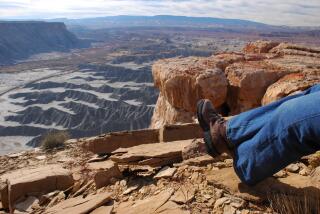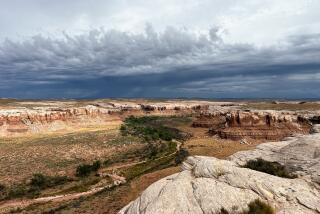National Park ‘Simply Isn’t Big Enough to Protect Itself’ : Modern World’s Encroachment Stirs Concern for Yellowstone’s Survival
- Share via
YELLOWSTONE NATIONAL PARK, Wyo. — In the beginning, when Congress got the idea to create the world’s first national park, everybody thought Yellowstone was plenty big enough because nobody went there.
That was in 1872.
Now Yellowstone National Park is America’s front porch, its backyard, its playground. The park’s ecosystem is also the largest intact wilderness left in the lower 48 states, and therein lies a major threat.
The ecosystem--that fragile balance of animals, plants, bacteria and chemicals--extends well beyond Yellowstone’s artificial borders, and it is being eaten away.
Just outside the park, industrialized man is building vacation homes, drilling for oil and gas, plumbing for geothermal energy, cutting down trees, carving out ski resorts, bulldozing roads, erecting dams, grazing livestock, plowing fields and generally raising havoc with the natural order of things.
A century after members of Congress set aside what are now parts of Idaho, Wyoming and Montana to be “withdrawn from settlement, occupancy or sale . . . dedicated . . . as a public park or pleasuring ground for the benefit and enjoyment of the people,” biologists, environmentalists and even federal bureaucrats are saying they goofed by reserving “only” 2.2 million acres.
“It simply isn’t big enough to protect itself,” said Destry Jarvis, executive director in Washington, D.C., of the 50,000-member National Parks and Conservation Assn., the private watchdog of national parks.
“When Yellowstone was created the world was a simple place. Two million acres seemed enormous.”
‘Key Lies Outside’
“Now we know that if we are to preserve the biological and geological features of this park, the key lies outside its boundaries.”
When naturalists talk about biology and geology, they mean treasures such as the Old Faithful geyser, dazzling water falls, bubbling hot springs, grizzly bears, elk, bighorn sheep, bison, bald eagles and trumpeter swans. These are the reason people go to Yellowstone, the reason Yellowstone was protected in the first place.
“Most of the . . . resource problems Yellowstone National Park faces today trace back to its creation,” the park superintendent, Robert D. Barbee, has said. “The earlier congressional oversight (has made Yellowstone) an ecological island.”
Yellowstone’s 62-by-54-mile rectangle is only part of an interdependent ecosystem. Always, the great bears and lesser beasts have roamed beyond the park’s bubbling caldrons and roaring waters.
When President Ulysses S. Grant signed the bill designating Yellowstone as the world’s first national park on March 1, 1872, he made law a notion that historian Wallace Stegner later hailed as “the best idea we ever had.”
The Earth’s mother park has spawned more than 2,600 national parks and preserves in 137 nations.
When Yellowstone was set aside for posterity, nearly everything west of the 100th meridian was wilderness. Now, the park contains restaurants, hotels, cabins, lodges, campsites with showers and coin laundries, gas stations, plug-ins for microwaves and pumps for portable toilets. Last year, 2,262,969 tourists visited Yellowstone.
The growing pressures on the park prompted formation in 1982 of the Greater Yellowstone Coalition, a grass-roots movement of 43 organizations, based in Bozeman, Mont. It lobbies for cohesive management of an area it defines as the entire Yellowstone ecosystem, an area the size of Massachusetts.
“If one area is damaged, then the whole suffers,” said Bob Anderson, the coalition’s executive director. “The park itself is 2.2 million acres, but the complete unit extends more than 6 million acres.
“Since we didn’t protect the whole ecosystem, we probably can’t protect the wildlife and the geysers in the part that has been designated the national park.”
The core of the ecosystem is Yellowstone and its 300,000-acre neighbor, Grand Teton National Park. It extends to include two national wildlife refuges, six national forests and private lands spread over three states and 13 counties. These are managed by more than 25 political jurisdictions, which are frequently at odds over each other’s goals.
Anderson said the coalition aims to persuade the federal government to establish an integrated management system to oversee the ecosystem as a whole.
Opposition to such umbrella management comes from developers, ranchers, loggers and wildcatters searching for oil and gas. They say environmentalists want to lock up the West’s public lands.
Wyoming’s sole congressman, Dick Cheney, has said a buffer zone plan for Yellowstone won’t “be an easy one to sell” in Congress.
The idea, however, recently gained a powerful ally. The new National Park Service director, William Penn Mott, spent five days touring Yellowstone this summer. He pledged to work “to create a legal buffer zone around the park that represents the entire ecosystem.”
Warns Against Overuse
“When in doubt, we must err on the side of preservation,” Mott told coalition supporters. “Overuse now or in the future will not let us easily restore a loss of resource values or character, which, once gone, is irretrievable.”
The formula for survival, environmentalists say, lies with the six national forests that compose 60% of the Yellowstone country.
Those forests, along with the nation’s 149 other national forests, are completing projected 50-year management plans and environmental impact statements. The plans, due by Dec. 31, were ordered under the 1976 National Forest Management Act.
“For the first time we have been mandated to look at the whole instead of just the pieces,” said Fred Kingwill, spokesman for the 3.4-million acre Bridger-Teton National Forest near Jackson, Wyo.
“The management plans will take into account all aspects of the public’s multiuse forests: wildlife, the watershed, grazing, timber harvesting, recreation, oil and gas exploration, visuals.”
It is an old debate, this argument about how much is too much.
On March 1, 1883, in a debate on the floor of the U.S. Senate, John James Ingalls, a Kansas Republican, allowed as how “the best thing that the government could do with the Yellowstone National Park is to survey it and sell it.”
The reply came from Missouri Democrat, George Graham Vest:
“I am not ashamed to say that I shall vote to perpetuate this park to the American people. . . . Its existence answers a great purpose in our national life. There should be to a nation that will have 100 million or 150 million people, a park like this as a great breathing-place for the national lungs.”
More to Read
Sign up for Essential California
The most important California stories and recommendations in your inbox every morning.
You may occasionally receive promotional content from the Los Angeles Times.










